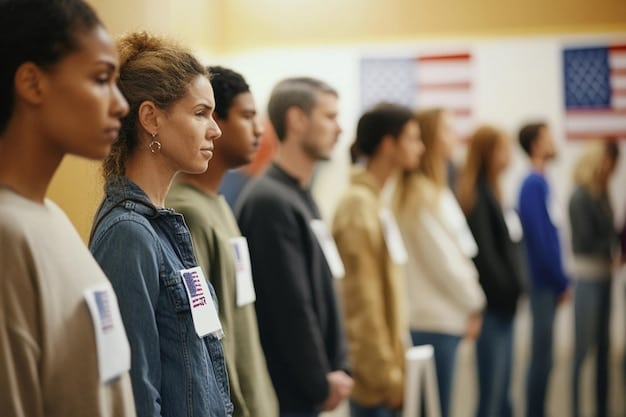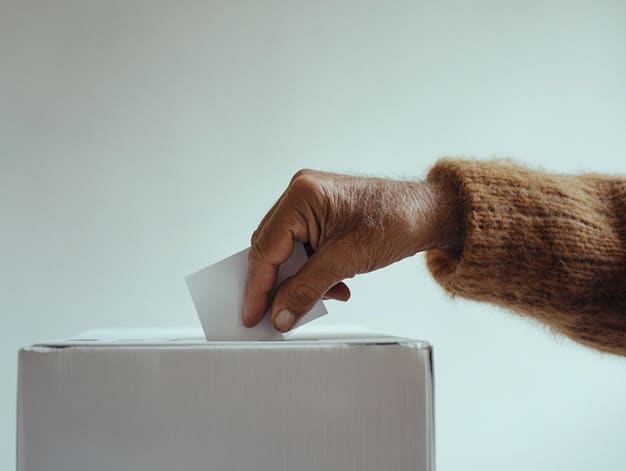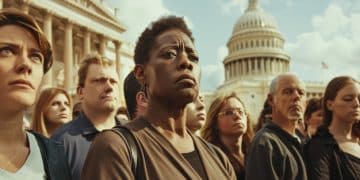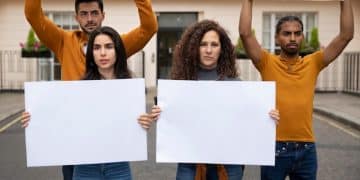Proposed 2025 Voting Rights Changes: Impact on Minority Communities

How Will the Proposed 2025 Changes to Federal Voting Rights Impact Minority Communities? Potential changes to federal voting rights in 2025 could disproportionately affect minority communities, raising concerns about access to the ballot box and the preservation of democratic principles.
The landscape of voting rights in the United States is constantly evolving, and proposed changes for 2025 are raising significant concerns, especially within minority communities. Let’s delve into How Will the Proposed 2025 Changes to Federal Voting Rights Impact Minority Communities? and what potential challenges and consequences they might face.
Understanding the Current Federal Voting Rights Landscape
To fully comprehend the potential impact of the proposed 2025 changes, it’s essential to first understand the current framework of federal voting rights. This involves examining key legislation and historical precedents that have shaped the modern voting landscape.
The Voting Rights Act of 1965
The Voting Rights Act of 1965 (VRA) stands as a cornerstone of American civil rights. It was enacted to combat discriminatory voting practices, particularly in the Southern states. This landmark legislation has played a pivotal role in expanding access to the ballot box for minority voters.
Key Provisions and Protections
The VRA introduced several key provisions, including:
- Preclearance: Certain jurisdictions with a history of voting discrimination were required to obtain federal approval before implementing any changes to their voting laws.
- Section 2: A nationwide prohibition against voting practices that discriminate based on race or color.
- Language Assistance: Mandates that jurisdictions with significant populations of voters who speak languages other than English provide bilingual voting materials and assistance.

Supreme Court’s Shelby County v. Holder Decision
In 2013, the Supreme Court’s decision in Shelby County v. Holder significantly altered the landscape of the VRA. The court struck down the formula used to determine which jurisdictions were subject to preclearance, effectively removing this critical safeguard.
The consequences of this decision have been widely debated. Some argue that it has led to a resurgence of discriminatory voting practices, while others claim that it has simply eliminated an outdated and unnecessary burden on certain states.
The current federal voting rights landscape is a complex mix of historical protections and recent legal challenges. Understanding these dynamics is crucial for assessing the potential impact of the proposed 2025 changes on minority communities. This complex mix shapes the opportunities and challenges faced by minority voters today.
Overview of the Proposed 2025 Changes to Voting Rights
Several proposed changes to federal voting rights are under consideration for 2025. These proposals aim to address perceived issues with the current system, but their potential consequences for minority communities remain a significant concern.
Voter ID Laws
One of the most debated proposals involves stricter voter ID laws. Proponents argue that these laws are necessary to prevent voter fraud and ensure the integrity of elections.
Critics, however, contend that these laws disproportionately disenfranchise minority voters, who are less likely to possess the required forms of identification. Studies have shown that minority groups often face barriers to obtaining IDs, such as lack of transportation, documentation, or financial resources.
Restrictions on Early Voting and Same-Day Registration
Another area of focus involves restrictions on early voting and same-day registration. These measures, proponents argue, can streamline the voting process and reduce administrative burdens.
However, opponents argue that they disproportionately affect minority voters who rely on these options due to work schedules, childcare responsibilities, or limited access to transportation. Early voting and same-day registration have been shown to increase voter turnout, particularly among minority groups.
Changes to Voter Roll Maintenance
Proposed changes to voter roll maintenance practices are also generating controversy. Advocates of stricter maintenance practices argue that they are necessary to remove ineligible voters, such as those who have moved or passed away.
Opponents, however, raise concerns that these practices can lead to the erroneous removal of eligible voters, particularly minority voters who may have limited English proficiency or who move frequently. Such purges can disproportionately impact communities with lower rates of homeownership and higher mobility rates.
In summary, the proposed 2025 changes to voting rights encompass a range of measures, each with potential implications for minority communities. Understanding these proposals is crucial for evaluating their potential impact and advocating for equitable access to the ballot box.
How These Changes Could Disproportionately Affect Minority Communities
The proposed 2025 changes to federal voting rights could disproportionately affect minority communities due to existing socioeconomic and political disparities. These disparities can amplify the impact of voting restrictions, creating additional barriers to participation.
Reduced Access to Polling Locations
One potential consequence is reduced access to polling locations. This can occur when polling places are closed or consolidated, particularly in minority neighborhoods. Factors contributing to this include:
- Rural areas with limited public transportation.
- Areas with a high concentration of low-income residents.
- Neighborhoods with a history of voter suppression tactics.
Increased Administrative Burdens
Stricter voter ID laws and changes to voter registration processes can create increased administrative burdens for minority voters. These burdens can include:
- Difficulty obtaining or updating required identification documents.
- Confusion about voter registration deadlines and requirements.
- Language barriers that make it challenging to navigate the voting process.

The Impact of Felony Disenfranchisement Laws
Felony disenfranchisement laws, which restrict the voting rights of individuals with criminal convictions, also disproportionately affect minority communities. These laws have historical roots in efforts to suppress the Black vote and continue to have a significant impact on minority voter turnout.
Challenges to Inclusive Voting Processes
Including measures to enfranchise all citizens regardless of background. This involves addressing systemic barriers and promoting policies that ensure equal access to the ballot box for all. In addition to these legal challenges, minority communities often face other obstacles to political participation. Challenges to inclusive voting processes involve:
- Targeted disinformation campaigns aimed at discouraging minority voters from participating.
- Efforts to intimidate or harass minority voters at polling locations.
- Lack of adequate language assistance and voter education resources.
The potential for the proposed 2025 changes to disproportionately affect minority communities is a serious concern. Understanding these potential consequences is crucial for advocating for policies that promote fair and equal access to the ballot box.
Historical Context of Voting Rights and Discrimination
Understanding the historical context of voting rights and discrimination provides essential insight into the potential impact of the proposed 2025 changes. The struggle for voting rights in the United States has been marked by persistent efforts to exclude minority groups from the democratic process.
Jim Crow Laws and Voter Suppression
Following the Civil War, Southern states enacted a series of discriminatory laws known as Jim Crow laws. These laws were designed to disenfranchise Black voters through various mechanisms, including:
- Poll taxes, which required voters to pay a fee to cast a ballot.
- Literacy tests, which required voters to demonstrate a certain level of reading and writing ability.
- Grandfather clauses, which exempted individuals from these requirements if their ancestors had been eligible to vote before the Civil War.
The Civil Rights Movement and Legislative Reforms
The Civil Rights Movement of the 1950s and 1960s played a pivotal role in dismantling Jim Crow laws and expanding voting rights. Activists organized protests, marches, and voter registration drives to challenge discriminatory practices.
These efforts led to the passage of landmark legislation, including the Voting Rights Act of 1965, which outlawed discriminatory voting practices and provided federal oversight of elections in certain states.
Ongoing Challenges and Contemporary Debates
Despite these historical reforms, challenges to voting rights persist. Contemporary debates over voter ID laws, redistricting, and other election-related issues reflect ongoing tensions between efforts to promote fairness and accessibility and efforts to restrict access to the ballot box.
Drawing Parallels to Modern-Day Challenges
Recognizing these historical patterns can help to contextualize modern-day challenges to voting rights and understand their potential impact on minority communities.
The historical struggle for voting rights underscores the importance of vigilance and advocacy in protecting and expanding access to the ballot box for all citizens. Only through continued efforts to combat discrimination and promote fairness can we ensure that the promise of democracy is fully realized.
Potential Legal Challenges and Advocacy Strategies
In light of the proposed 2025 changes to federal voting rights, legal challenges and advocacy strategies are critical for protecting the rights of minority communities. These strategies aim to ensure that any new voting laws are fair, equitable, and comply with constitutional principles.
Litigation and Legal Challenges
One potential avenue for challenging restrictive voting laws is through litigation. Civil rights organizations and advocacy groups can file lawsuits alleging that these laws violate the Voting Rights Act, the Fourteenth Amendment, or other constitutional provisions.
These lawsuits can seek to block the implementation of discriminatory voting laws or to compel states to adopt more inclusive voting practices.
Legislative and Policy Advocacy
Another important strategy is legislative and policy advocacy. This involves lobbying elected officials, organizing grassroots campaigns, and educating the public about the importance of protecting voting rights.
Advocates can work to defeat restrictive voting laws, promote legislation that expands access to the ballot box, and ensure that election officials are implementing voting laws in a fair and non-discriminatory manner.
Community Organizing and Voter Education
Community organizing and voter education are also essential for empowering minority voters and ensuring that they can exercise their right to vote. This involves:
- Conducting voter registration drives in minority communities.
- Providing voter education materials in multiple languages.
- Organizing transportation to polling locations for voters who lack access to transportation.
Collaborating with Community Stakeholders
Advocating for Policy Reforms by collaborating with community stakeholders and engaging with elected officials in this context can amplify the voices of those most affected by changes to voting rights and promote evidence-based policy solutions. Here are some steps that can be taken:
- Working to establish independent redistricting commissions to prevent gerrymandering.
- Pushing for automatic voter registration to streamline the registration process.
- Supporting the restoration of voting rights for individuals with criminal convictions.
Legal challenges and advocacy strategies are essential for protecting the voting rights of minority communities and ensuring that all citizens have an equal opportunity to participate in the democratic process. These efforts require collaboration, dedication, and a commitment to the principles of fairness, equality, and justice.
The Role of Grassroots Movements and Community Engagement
Grassroots movements and community engagement play a crucial role in safeguarding voting rights, particularly within minority communities. These efforts empower individuals to take collective action, advocate for policy changes, and ensure that their voices are heard.
Building Coalitions and Partnerships
One key aspect of grassroots organizing is building coalitions and partnerships. This involves bringing together diverse groups of people, including community organizations, faith-based institutions, and civil rights groups, to work towards common goals.
By building strong coalitions, advocates can amplify their voices and increase their impact on policy decisions.
Empowering Local Leadership
Grassroots movements also focus on empowering local leadership. This involves:
- Identifying and training community members to become leaders and advocates.
- Providing resources and support to enable them to organize and mobilize their communities.
- Creating opportunities for local leaders to engage with elected officials and decision-makers.
Digital Organizing and Social Media
In today’s digital age, social media and digital organizing tools are also crucial for grassroots movements. Social media platforms can be used to:
- Raise awareness about voting rights issues.
- Share information about upcoming elections and voter registration deadlines.
- Mobilize supporters to attend rallies, protests, and other events.
| Key Point | Brief Description |
|---|---|
| 🗳️ Voter ID Laws | Stricter ID laws can disproportionately affect minority voters. |
| 🗓️ Early Voting | Restrictions on early voting can reduce minority turnout. |
| ⚖️ Legal Challenges | Lawsuits can challenge discriminatory voting laws. |
| 🤝 Community Engagement | Grassroots movements safeguard voting rights. |
Frequently Asked Questions
What potential changes to federal voting rights are proposed for 2025?
Potential changes for 2025 include stricter voter ID laws, restrictions on early voting, and changes to voter roll maintenance.
How might stricter voter ID laws affect minority communities?
Stricter voter ID laws can disproportionately disenfranchise minority voters who may lack required identification or face barriers to obtaining it.
What role did the Voting Rights Act of 1965 play in protecting minority voting rights?
The Voting Rights Act of 1965 outlawed discriminatory voting practices, particularly in the Southern states, and expanded access to the ballot box for minority voters.
How can communities organize to protect voting rights?
Communities can organize voter registration drives, provide education materials, and mobilize supporters to advocate for policy changes and ensure fair elections.
What is the significance of the Shelby County v. Holder Supreme Court decision?
The Shelby County v. Holder decision in 2013 struck down a key provision of the Voting Rights Act, leading to concerns about a resurgence of discriminatory voting practices.
Conclusion
Voting rights in the United States remain a contested issue, and proposed changes for 2025 could significantly impact minority communities. By understanding the historical context, potential consequences, and strategies for advocacy, we can work towards a more inclusive and equitable democracy.





